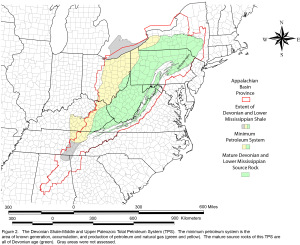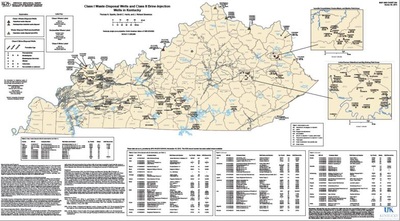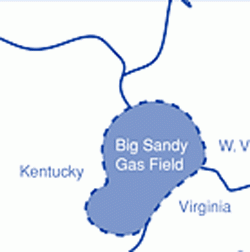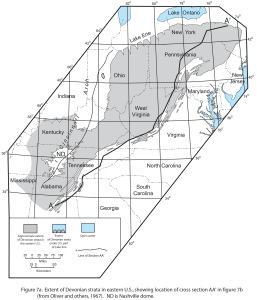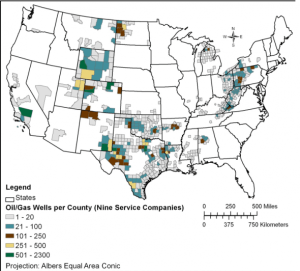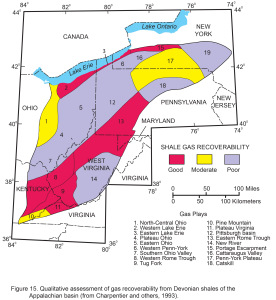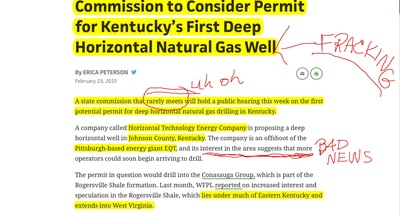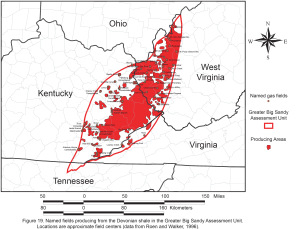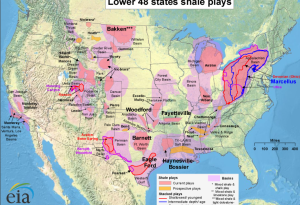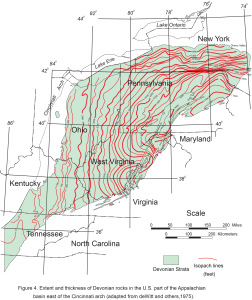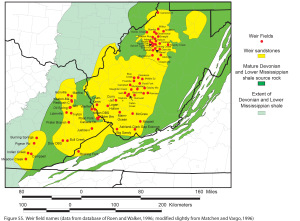|
|
|
|
FRACKING IN KENTUCKY - BALLOTPEDIA
Regulatory agency: Division of Oil and Gas, Department of Natural Resources Fossil fuel reserves: Oil, natural gas and coal Crude oil wells: 0 Percent of U.S. crude oil wells: 0.0% Crude oil production rank: 21st Natural gas wells: 18,087 Percent of U.S. natural gas wells: 3.71% Natural gas production rank: 20th Severance tax revenue: $241,989,000 Water used for mining: 34,500 acre feet Percent of state's water use: 0.71% Injection wells: 3,165 Percent of U.S. injection wells: 1.88% |
LINK TO MAP OF FRACKING IN KENTUCKY
Seismologists monitor northeastern Kentucky as companies show interest in fracking Rogersville shale
Read more here: http://www.kentucky.com/2015/06/28/3921948_seismologists-monitor-northeastern.html?rh=1#storylink=cpy
By Bill Estep
[email protected]June 28, 2015
WEBBVILLE — If the continued interest in exploring for oil far below the surface of northeastern Kentucky ever results in a production boom, researchers will be ready to gauge the effect on earthquakes.
Seismologists with the Kentucky Geological Survey at the University of Kentucky are installing a network of highly sensitive seismic monitoring stations in the area this summer.
Other parts of the country have experienced more low-level earthquake activity after an increase in the use of high-pressure hydraulic fracturing, or fracking, to produce oil and gas. That matters in Kentucky because there could someday be far more drilling and fracking of deep, horizontal wells in an ancient geologic layer called the Rogersville shale.
Several companies have drilled test wells in Lawrence and Johnson counties to explore the Rogersville.
Seth Carpenter, a seismologist with the Kentucky Geological Survey, is leading a project to install at least 15 stations in the region to measure ground movement.
The goal is to collect baseline data on earthquake activity in the region before any significant increase in oil production there. Then, if that development comes, researchers will have better information to measure its impact, if any, on the number and strength of earthquakes.
"That's the primary benefit to the state," Carpenter said.
There are seismic monitoring stations in the region now, but the ones Carpenter and colleagues are installing are more sensitive and are being placed closer together, so they can register smaller earthquakes. The new stations also will help provide information to better assess the earthquake hazard in the area.
Interest in the Rogersville shale spiked beginning about two years ago based on research that showed the shale could hold significant amounts of oil and gas.
There has been oil and gas development in the area for decades, but not in the Rogersville shale layer, which lies 9,000 feet or more below the surface.
Companies signed hundreds of new leases with mineral owners in the area in 2013 and 2014.
The potential to develop the deep shale layer results from a combination of horizontal drilling and fracking.
Traditional oil wells involve drilling a vertical hole. However, companies developed the ability to curve the pipe as it proceeds underground, meaning it goes down a certain depth and then travels horizontally in a band of rock containing oil or gas, allowing producers to tap a bigger area.
Companies are believed to have drilled — or gotten permits to drill — at least half a dozen deep wells in Lawrence and Johnson counties since 2013 to figure out whether there is sufficient oil in the Rogersville shale to justify commercial development, according to people familiar with the issue.
Companies are allowed to keep much information about test wells secret, but it's clear there is a good deal of interest, said David C. Harris, who heads the Energy & Minerals Section of the Kentucky Geological Survey.
"I think they're trying to prove what's there," said Harris, who has researched the shale.
Fracking involves injecting water — millions of gallons, in some cases — chemicals, and an agent such as sand into boreholes at high pressure to break up rock, freeing oil, gas and natural-gas liquids such as propane and butane locked in tiny pores.
Companies can re-use some of the liquid that flows back up from the hole, but a good deal is wastewater that is typically injected into underground wells, often under pressure.
Wastewater injection has been linked to an increase in earthquakes — called induced seismicity — elsewhere in the country, according to the U.S. Geological Survey.
In one case, such disposal was a contributing factor in a 2011 earthquake in rural Oklahoma that damaged more than a dozen homes and caused a few injuries, according to the agency.
The quake would have caused much more damage in a more densely populated area, the agency said.
Injecting water from oil and gas production into wells can cause earthquakes because it changes the stress on existing faults underground.
The faults are typically at equilibrium because friction counters the push of Earth's plates against them, but the pressure from injecting fluid can alter the balance, Carpenter said.
However, he said the orientation of the fault and other factors have to align for that to happen. Relatively few injection wells in the country have contributed to a fault failing, he said.
"To make these faults fail by injecting fluids, the geologic conditions have to be just right," Carpenter said.
Oil and gas production has not been blamed for any damaging earthquakes in Kentucky. But the state hasn't seen the magnitude of fracking and related wastewater disposal that has ballooned in Texas, Oklahoma and other states in recent years.
Carpenter said it's not likely that fracking or underground injection of wastewater would cause a damaging earthquake in Eastern Kentucky, but he said researchers don't have enough information to rule that out.
Mining and other activities already routinely induce small earthquakes in Kentucky, most of them too small to feel. There will be a greater chance for quakes large enough to be felt as companies inject more waste liquid into the ground, Carpenter said.
The data from the increased seismic monitoring will help researchers differentiate between natural and man-made quakes.
The stations include a very sensitive seismometer and equipment to record data and transmit the information to the KGS office at UK by cellular communication. The units are powered by batteries and have a solar panel to charge the batteries.
The oil industry, an instrumentation maker called Nanometrics Inc., and the UK Department of Earth and Environmental Sciences are participating in the project with the Kentucky Geological Survey.
Carpenter, fellow seismologist Zhenming Wang and Andrew Holcomb, a UK graduate student, have installed four of the units so far this summer, working in the heat to dig holes for a stand to mount the solar panel and electronics and to bury the seismometer.
While the network will help answer one issue related to large-scale fracking, the practice has been controversial for other reasons as well, including concerns about water use, emissions of methane and other pollutants at drill sites, spills or leaks of liquid that contain hazardous chemicals, and heavy truck traffic in rural areas.
The U.S. Environmental Protection Agency said in a study published this month that there have been cases around the country of contamination of wells and water sources because of fracking operations. However, the agency said the number of incidents was small compared to the tens of thousands of wells that have been stimulated with hydraulic fracturing.
The EPA said it found no widespread, systematic harm to water from fracking, though it noted there was a lack of data on some issues, including information needed to compare water quality before and after fracking.
The agency said it could not estimate the frequency of spills at well sites for most states. In the two it could, the estimated number of spills was one per 100 wells in Colorado, but up to 12.2 per 100 in Pennsylvania, the agency said.
Lawrence County Judge-Executive John Osborne said he is concerned about the potential impact on water — including leaks from injection wells — if Rogersville shale production spikes.
"There might not be no good water in Eastern Kentucky," Osborne said. "I have that concern about the future."
State lawmakers approved new rules this year to get ahead of high-volume fracking in Kentucky, requiring water testing near deep horizontal wells; notice to nearby landowners; plans to reclaim well sites; disclosure of the names of chemicals used in fracking; and bonds to cover the cost of plugging and reclaiming wells.
The legislation, which resulted from cooperation between industry, regulators and environmentalists, did not address injection wells or induced seismicity.
However, the group that recommended the changes continues to meet and those issues are part of the discussion, said Andrew V. McNeill, executive director of the Kentucky Oil and Gas Association.
The oil and gas industry contends that hydraulic fracturing is a proven, safe technology that poses no threat to groundwater.
The water and chemicals needed to unlock oil from tight rock formations is typically injected far below the water table.
And Kentucky requires companies to cement steel casings in boreholes to prevent oil or chemicals from escaping into the water table.
Studies have not found significant problems with fracking chemicals leaking from boreholes and contaminating groundwater.
Monte Hay, the fourth generation of his family to be involved in oil and gas exploration in northeast Kentucky, said most operators act responsibly and want to avoid environmental problems, which can be expensive.
"You try to be good stewards of the environment," said Hay, a geologist who operates Hay Exploration Inc. in Ashland.
Lawrence County has been Kentucky's version of the national oil boom. The county did not rank in the top 10 oil producers in the state in 2010, but finished 2014 in front by a wide margin.
Companies pumped 531,676 barrels of oil from beneath Lawrence County last year, more than 10 times the county's 2010 production of 43,105 barrels, according to the Kentucky Department of Revenue. The second-biggest producer in 2014 was Lee County with 307,129 barrels.
The increased activity has helped the local economy, according to officials and businesspeople.
Drilling companies have not hired many local people, but employees and mineral-leasing agents have bought food and gas and helped keep motels full.
The spike in production also has meant a windfall for owners of mineral rights and increased tax revenue for the county.
The state Department for Local Government said the county's share of the state mineral-severance tax went from $150,071 in fiscal year 2013 to $673,563 in fiscal year 2014, which ended last June 30. The county received $512,599 in the first half of the current fiscal year.
As in other parts of the country, however, the drilling boom in Lawrence County has dwindled in recent months because of a drop in oil prices. Companies are still pulling oil from wells put in earlier, but there is little new development.
The jump in production in the county in 2013 and 2014 was from horizontal wells drilled into a layer called the Berea sandstone, which is about 1,500 feet down. It costs far more to put a horizontal well into the much deeper Rogersville shale — $15 million or more.
The fact that companies are still willing to make that investment, even with oil prices so low, is reason for cautious optimism that there will someday be significantly more production and resulting jobs in the area, McNeill said.
The current oil price of about $60 a barrel is not high enough to make it economically feasible to produce deep horizontal wells in the Rogersville, however, Hay said.
And it's still not known if there is enough oil for a significant play, he said.
"It's all a science project now," Hay said. "Will it be commercial? Nobody knows that."
Bill Estep: (606) 678-4655. Twitter: @billestep1
SOURCE
Read more here: http://www.kentucky.com/2015/06/28/3921948_seismologists-monitor-northeastern.html?rh=1#storylink=cpy
Seismologists monitor northeastern Kentucky as companies show interest in fracking Rogersville shale
Read more here: http://www.kentucky.com/2015/06/28/3921948_seismologists-monitor-northeastern.html?rh=1#storylink=cpy
By Bill Estep
[email protected]June 28, 2015
WEBBVILLE — If the continued interest in exploring for oil far below the surface of northeastern Kentucky ever results in a production boom, researchers will be ready to gauge the effect on earthquakes.
Seismologists with the Kentucky Geological Survey at the University of Kentucky are installing a network of highly sensitive seismic monitoring stations in the area this summer.
Other parts of the country have experienced more low-level earthquake activity after an increase in the use of high-pressure hydraulic fracturing, or fracking, to produce oil and gas. That matters in Kentucky because there could someday be far more drilling and fracking of deep, horizontal wells in an ancient geologic layer called the Rogersville shale.
Several companies have drilled test wells in Lawrence and Johnson counties to explore the Rogersville.
Seth Carpenter, a seismologist with the Kentucky Geological Survey, is leading a project to install at least 15 stations in the region to measure ground movement.
The goal is to collect baseline data on earthquake activity in the region before any significant increase in oil production there. Then, if that development comes, researchers will have better information to measure its impact, if any, on the number and strength of earthquakes.
"That's the primary benefit to the state," Carpenter said.
There are seismic monitoring stations in the region now, but the ones Carpenter and colleagues are installing are more sensitive and are being placed closer together, so they can register smaller earthquakes. The new stations also will help provide information to better assess the earthquake hazard in the area.
Interest in the Rogersville shale spiked beginning about two years ago based on research that showed the shale could hold significant amounts of oil and gas.
There has been oil and gas development in the area for decades, but not in the Rogersville shale layer, which lies 9,000 feet or more below the surface.
Companies signed hundreds of new leases with mineral owners in the area in 2013 and 2014.
The potential to develop the deep shale layer results from a combination of horizontal drilling and fracking.
Traditional oil wells involve drilling a vertical hole. However, companies developed the ability to curve the pipe as it proceeds underground, meaning it goes down a certain depth and then travels horizontally in a band of rock containing oil or gas, allowing producers to tap a bigger area.
Companies are believed to have drilled — or gotten permits to drill — at least half a dozen deep wells in Lawrence and Johnson counties since 2013 to figure out whether there is sufficient oil in the Rogersville shale to justify commercial development, according to people familiar with the issue.
Companies are allowed to keep much information about test wells secret, but it's clear there is a good deal of interest, said David C. Harris, who heads the Energy & Minerals Section of the Kentucky Geological Survey.
"I think they're trying to prove what's there," said Harris, who has researched the shale.
Fracking involves injecting water — millions of gallons, in some cases — chemicals, and an agent such as sand into boreholes at high pressure to break up rock, freeing oil, gas and natural-gas liquids such as propane and butane locked in tiny pores.
Companies can re-use some of the liquid that flows back up from the hole, but a good deal is wastewater that is typically injected into underground wells, often under pressure.
Wastewater injection has been linked to an increase in earthquakes — called induced seismicity — elsewhere in the country, according to the U.S. Geological Survey.
In one case, such disposal was a contributing factor in a 2011 earthquake in rural Oklahoma that damaged more than a dozen homes and caused a few injuries, according to the agency.
The quake would have caused much more damage in a more densely populated area, the agency said.
Injecting water from oil and gas production into wells can cause earthquakes because it changes the stress on existing faults underground.
The faults are typically at equilibrium because friction counters the push of Earth's plates against them, but the pressure from injecting fluid can alter the balance, Carpenter said.
However, he said the orientation of the fault and other factors have to align for that to happen. Relatively few injection wells in the country have contributed to a fault failing, he said.
"To make these faults fail by injecting fluids, the geologic conditions have to be just right," Carpenter said.
Oil and gas production has not been blamed for any damaging earthquakes in Kentucky. But the state hasn't seen the magnitude of fracking and related wastewater disposal that has ballooned in Texas, Oklahoma and other states in recent years.
Carpenter said it's not likely that fracking or underground injection of wastewater would cause a damaging earthquake in Eastern Kentucky, but he said researchers don't have enough information to rule that out.
Mining and other activities already routinely induce small earthquakes in Kentucky, most of them too small to feel. There will be a greater chance for quakes large enough to be felt as companies inject more waste liquid into the ground, Carpenter said.
The data from the increased seismic monitoring will help researchers differentiate between natural and man-made quakes.
The stations include a very sensitive seismometer and equipment to record data and transmit the information to the KGS office at UK by cellular communication. The units are powered by batteries and have a solar panel to charge the batteries.
The oil industry, an instrumentation maker called Nanometrics Inc., and the UK Department of Earth and Environmental Sciences are participating in the project with the Kentucky Geological Survey.
Carpenter, fellow seismologist Zhenming Wang and Andrew Holcomb, a UK graduate student, have installed four of the units so far this summer, working in the heat to dig holes for a stand to mount the solar panel and electronics and to bury the seismometer.
While the network will help answer one issue related to large-scale fracking, the practice has been controversial for other reasons as well, including concerns about water use, emissions of methane and other pollutants at drill sites, spills or leaks of liquid that contain hazardous chemicals, and heavy truck traffic in rural areas.
The U.S. Environmental Protection Agency said in a study published this month that there have been cases around the country of contamination of wells and water sources because of fracking operations. However, the agency said the number of incidents was small compared to the tens of thousands of wells that have been stimulated with hydraulic fracturing.
The EPA said it found no widespread, systematic harm to water from fracking, though it noted there was a lack of data on some issues, including information needed to compare water quality before and after fracking.
The agency said it could not estimate the frequency of spills at well sites for most states. In the two it could, the estimated number of spills was one per 100 wells in Colorado, but up to 12.2 per 100 in Pennsylvania, the agency said.
Lawrence County Judge-Executive John Osborne said he is concerned about the potential impact on water — including leaks from injection wells — if Rogersville shale production spikes.
"There might not be no good water in Eastern Kentucky," Osborne said. "I have that concern about the future."
State lawmakers approved new rules this year to get ahead of high-volume fracking in Kentucky, requiring water testing near deep horizontal wells; notice to nearby landowners; plans to reclaim well sites; disclosure of the names of chemicals used in fracking; and bonds to cover the cost of plugging and reclaiming wells.
The legislation, which resulted from cooperation between industry, regulators and environmentalists, did not address injection wells or induced seismicity.
However, the group that recommended the changes continues to meet and those issues are part of the discussion, said Andrew V. McNeill, executive director of the Kentucky Oil and Gas Association.
The oil and gas industry contends that hydraulic fracturing is a proven, safe technology that poses no threat to groundwater.
The water and chemicals needed to unlock oil from tight rock formations is typically injected far below the water table.
And Kentucky requires companies to cement steel casings in boreholes to prevent oil or chemicals from escaping into the water table.
Studies have not found significant problems with fracking chemicals leaking from boreholes and contaminating groundwater.
Monte Hay, the fourth generation of his family to be involved in oil and gas exploration in northeast Kentucky, said most operators act responsibly and want to avoid environmental problems, which can be expensive.
"You try to be good stewards of the environment," said Hay, a geologist who operates Hay Exploration Inc. in Ashland.
Lawrence County has been Kentucky's version of the national oil boom. The county did not rank in the top 10 oil producers in the state in 2010, but finished 2014 in front by a wide margin.
Companies pumped 531,676 barrels of oil from beneath Lawrence County last year, more than 10 times the county's 2010 production of 43,105 barrels, according to the Kentucky Department of Revenue. The second-biggest producer in 2014 was Lee County with 307,129 barrels.
The increased activity has helped the local economy, according to officials and businesspeople.
Drilling companies have not hired many local people, but employees and mineral-leasing agents have bought food and gas and helped keep motels full.
The spike in production also has meant a windfall for owners of mineral rights and increased tax revenue for the county.
The state Department for Local Government said the county's share of the state mineral-severance tax went from $150,071 in fiscal year 2013 to $673,563 in fiscal year 2014, which ended last June 30. The county received $512,599 in the first half of the current fiscal year.
As in other parts of the country, however, the drilling boom in Lawrence County has dwindled in recent months because of a drop in oil prices. Companies are still pulling oil from wells put in earlier, but there is little new development.
The jump in production in the county in 2013 and 2014 was from horizontal wells drilled into a layer called the Berea sandstone, which is about 1,500 feet down. It costs far more to put a horizontal well into the much deeper Rogersville shale — $15 million or more.
The fact that companies are still willing to make that investment, even with oil prices so low, is reason for cautious optimism that there will someday be significantly more production and resulting jobs in the area, McNeill said.
The current oil price of about $60 a barrel is not high enough to make it economically feasible to produce deep horizontal wells in the Rogersville, however, Hay said.
And it's still not known if there is enough oil for a significant play, he said.
"It's all a science project now," Hay said. "Will it be commercial? Nobody knows that."
Bill Estep: (606) 678-4655. Twitter: @billestep1
SOURCE
Read more here: http://www.kentucky.com/2015/06/28/3921948_seismologists-monitor-northeastern.html?rh=1#storylink=cpy
Residents Ask For Moratorium on Fracking in Kentucky
By Ryland Barton July 24, 2015
Residents expressed concerns this week that the potential expansion of hydraulic fracturing, or fracking, in Kentucky would pollute the water and air and bring earthquakes to the region.
About 50 people attended the “listening session” held Thursday evening by the state Energy and Environment Cabinet in Somerset. Xyara Asplen was one of several people calling for a moratorium on fracking.
“Implement a moratorium on high-volume hydraulic fracturing until such a time as it can be demonstrated that the risk to our health, our homes and the quality of life for our families is worth the benefits to those few who will profit,” she said at the meeting.
Asplen says her family was approached by representatives of Lexington Energy, a Utah-based company that has been securing leases on land in Eastern Kentucky.
Interest in Eastern Kentucky’s Rogersville Shale has increased as test wells recently showed the potential for “vast reserves” of gas trapped in shale deep below the surface.
So far, the major fracking plays have been in Texas, Oklahoma, North Dakota, Pennsylvania, New York, West Virginia and Ohio, but the process has mostly been absent from Kentucky.
The process involves drilling down into the earth and injecting water, sand and chemicals to release gas from shale formations up sometimes over two miles underground.
Related Story Is Fracking Coming to the Cumberlands?
And though the EPA earlier this year released a study that found no widespread drinking water pollution from the process, many citizens at the meeting were concerned that Kentucky’s porous limestone rock and cave formations would lend themselves to far-reaching contamination from fracking.
Also, some of the residents who spoke said they worried that fracking would lead to a spike in seismic events. Such events in Oklahoma and Texas have been linked to the underground disposal of “flowback” water, a byproduct of the fracking process.
J.P. Brantley, a member of environmental group Kentuckians for the Commonwealth, pointed to news reports that linked fracking to increased traffic in rural areas leading to overtaxed infrastructure and crumbling roads.
“Their primary concern is making money. The land, people and communities affected by fracking are at best secondary for them,” Brantley said.
Reports of land agents working to secure mineral leases for energy companies have increased this year. At the forum on Thursday evening, Kentucky Environmental Foundation program director Craig Williams said landowners have been asked to sign contracts without even reading them.
“This can only be viewed as an indication of how landowners will be treated if fracking does occur in these areas,” Williams said.
Energy and Environment Cabinet spokesman Dick Brown said after the meeting that there’s been an increase in “land men who are out trying to purchase leases, betting on the future.”
“Unfortunately we have no ability to regulate that. That’s not our purview,” Brown said. “Our advice to people is if someone approaches them, don’t ever sign anything unless you know what’s in it and consult an attorney.”
The state legislature recently passed regulations on the fracking industry including water quality testing, disclosure of chemicals injected underground in the process and a requirement for companies to reclaim land around injection sites.
Another “listening” session will take place in Hazard on July 30.
fracking Ryland Barton Ryland Barton is the Capitol bureau chief for Kentucky Public Radio.
@RylandKY
SOURCE http://wfpl.org/residents-ask-moratorium-fracking-kentucky/
By Ryland Barton July 24, 2015
Residents expressed concerns this week that the potential expansion of hydraulic fracturing, or fracking, in Kentucky would pollute the water and air and bring earthquakes to the region.
About 50 people attended the “listening session” held Thursday evening by the state Energy and Environment Cabinet in Somerset. Xyara Asplen was one of several people calling for a moratorium on fracking.
“Implement a moratorium on high-volume hydraulic fracturing until such a time as it can be demonstrated that the risk to our health, our homes and the quality of life for our families is worth the benefits to those few who will profit,” she said at the meeting.
Asplen says her family was approached by representatives of Lexington Energy, a Utah-based company that has been securing leases on land in Eastern Kentucky.
Interest in Eastern Kentucky’s Rogersville Shale has increased as test wells recently showed the potential for “vast reserves” of gas trapped in shale deep below the surface.
So far, the major fracking plays have been in Texas, Oklahoma, North Dakota, Pennsylvania, New York, West Virginia and Ohio, but the process has mostly been absent from Kentucky.
The process involves drilling down into the earth and injecting water, sand and chemicals to release gas from shale formations up sometimes over two miles underground.
Related Story Is Fracking Coming to the Cumberlands?
And though the EPA earlier this year released a study that found no widespread drinking water pollution from the process, many citizens at the meeting were concerned that Kentucky’s porous limestone rock and cave formations would lend themselves to far-reaching contamination from fracking.
Also, some of the residents who spoke said they worried that fracking would lead to a spike in seismic events. Such events in Oklahoma and Texas have been linked to the underground disposal of “flowback” water, a byproduct of the fracking process.
J.P. Brantley, a member of environmental group Kentuckians for the Commonwealth, pointed to news reports that linked fracking to increased traffic in rural areas leading to overtaxed infrastructure and crumbling roads.
“Their primary concern is making money. The land, people and communities affected by fracking are at best secondary for them,” Brantley said.
Reports of land agents working to secure mineral leases for energy companies have increased this year. At the forum on Thursday evening, Kentucky Environmental Foundation program director Craig Williams said landowners have been asked to sign contracts without even reading them.
“This can only be viewed as an indication of how landowners will be treated if fracking does occur in these areas,” Williams said.
Energy and Environment Cabinet spokesman Dick Brown said after the meeting that there’s been an increase in “land men who are out trying to purchase leases, betting on the future.”
“Unfortunately we have no ability to regulate that. That’s not our purview,” Brown said. “Our advice to people is if someone approaches them, don’t ever sign anything unless you know what’s in it and consult an attorney.”
The state legislature recently passed regulations on the fracking industry including water quality testing, disclosure of chemicals injected underground in the process and a requirement for companies to reclaim land around injection sites.
Another “listening” session will take place in Hazard on July 30.
fracking Ryland Barton Ryland Barton is the Capitol bureau chief for Kentucky Public Radio.
@RylandKY
SOURCE http://wfpl.org/residents-ask-moratorium-fracking-kentucky/
Oil, gas companies show increased interest in Kentucky, sparking concerns about fracking
http://www.dailyjournal.net/view/story/9e60eed7a11143d1800ec8e1717b3751/KY--Fracking-Debate/
LEXINGTON, Kentucky — The debate over hydraulic fracturing, a technique used to drill oil and natural gas wells, may be coming to Kentucky.
The Lexington Herald-Leader (http://bit.ly/14r9rOQ) reports there's been increased interest among oil and gas companies in areas of eastern and central Kentucky. Local officials told the newspaper that companies have signed hundreds of new oil and gas leases with property owners over the last year.
Many of the leases are in Lawrence, Johnson and Magoffin counties, though some are in Madison and Rockcastle counties.
Industry engineers say the practice of fracking is safe, but groups have raised concerns over how it affects the environment.
Studies by Kentucky Geological Survey and others show there could be significant pocket of oil and gas in the Rogersville shale and that's what the companies have interest in.
Johnson County Clerk Sallee Holbrook said there were 1,331 oil and gas leases signed in 2014, compared to 406 in 2013. In Lawrence County, the number jumped from 1,041 in 2012 to 1,872 in 2013 before dipping in 2014. There were 395 leases filed in Magoffin County in 2014, compared with 72 the previous year.
Andrew V. McNeill, head of the Kentucky Oil and Gas Association, which is an industry group, says the leasing companies are locking up acreage, but that doesn't mean all of it will be drilled. He said the price of oil will play a major role in whether companies risk drilling in the Rogersville shale.
Meanwhile, some landowners have organized to try to persuade others not so sign leases.
"We want to protect a way of life and the natural environment as much as possible," said Phillip Gilbert, who lives on a 250-acre farm in northern Rockcastle County that's been in his family for over 100 years.
Tom FitzGerald, head of the Kentucky Resources Council, said he doesn't think current policies on drilling would adequately protect health and environment if large-scale hydraulic fracturing were to start in Kentucky.
"The current regulatory framework has significant gaps in protection of landowners and the environment," he said.
The state put together a working group last year to review oil and gas regulations partly due to the potential for more fracking, said Dick Brown, spokesman for the Kentucky Energy and Environment Cabinet.
As to concerns about environmental damage from fracking, Brown said, the work group's task "is to review our statutes to determine if controls are adequate and, if not, make recommendations to strengthen them."
Posted by Michael Surette at 10:02 AM
SOURCE
http://www.dailyjournal.net/view/story/9e60eed7a11143d1800ec8e1717b3751/KY--Fracking-Debate/
LEXINGTON, Kentucky — The debate over hydraulic fracturing, a technique used to drill oil and natural gas wells, may be coming to Kentucky.
The Lexington Herald-Leader (http://bit.ly/14r9rOQ) reports there's been increased interest among oil and gas companies in areas of eastern and central Kentucky. Local officials told the newspaper that companies have signed hundreds of new oil and gas leases with property owners over the last year.
Many of the leases are in Lawrence, Johnson and Magoffin counties, though some are in Madison and Rockcastle counties.
Industry engineers say the practice of fracking is safe, but groups have raised concerns over how it affects the environment.
Studies by Kentucky Geological Survey and others show there could be significant pocket of oil and gas in the Rogersville shale and that's what the companies have interest in.
Johnson County Clerk Sallee Holbrook said there were 1,331 oil and gas leases signed in 2014, compared to 406 in 2013. In Lawrence County, the number jumped from 1,041 in 2012 to 1,872 in 2013 before dipping in 2014. There were 395 leases filed in Magoffin County in 2014, compared with 72 the previous year.
Andrew V. McNeill, head of the Kentucky Oil and Gas Association, which is an industry group, says the leasing companies are locking up acreage, but that doesn't mean all of it will be drilled. He said the price of oil will play a major role in whether companies risk drilling in the Rogersville shale.
Meanwhile, some landowners have organized to try to persuade others not so sign leases.
"We want to protect a way of life and the natural environment as much as possible," said Phillip Gilbert, who lives on a 250-acre farm in northern Rockcastle County that's been in his family for over 100 years.
Tom FitzGerald, head of the Kentucky Resources Council, said he doesn't think current policies on drilling would adequately protect health and environment if large-scale hydraulic fracturing were to start in Kentucky.
"The current regulatory framework has significant gaps in protection of landowners and the environment," he said.
The state put together a working group last year to review oil and gas regulations partly due to the potential for more fracking, said Dick Brown, spokesman for the Kentucky Energy and Environment Cabinet.
As to concerns about environmental damage from fracking, Brown said, the work group's task "is to review our statutes to determine if controls are adequate and, if not, make recommendations to strengthen them."
Posted by Michael Surette at 10:02 AM
SOURCE
|
|
Truth Frequency Radio
By Sheree Geo Instead of asking why sinkholes are opening up everywhere at the same time as fracking (hydraulic fracturing for natural gas) is taking off across the United States, all people can talk about are the “eight ‘vettes” at the National Corvette Museum that were swallowed by the earth. Eight valuable ‘vettes at Bowling Green, Kentucky’s National Corvette Museum fell victim to a 40-foot-wide, 20-foot-deep sinkhole that opened up in the facility’s yellow Sky Dome wing. The museum unofficially estimates it caused millions of dollars in damage. Motion detectors alerted security that something was amiss shortly after 5:30 a.m., said museum spokeswoman Katie Frassinelli. An employee who first walked into the room “has been in shock all day,” she said. “When you go in there, it’s unreal,” said Frassinelli. “The hole is so big, it makes the Corvettes look like little Matchbox cars.” The news triggered a collective worldwide gasp from the Corvette Nation. “I was shocked,” said Frazer Bharucha, 47, a Corvette owner since age 17. “We’re talking about iconic cars that have been around for years.” I’m talking about underground rock formations that have been around for millions of years! According to the Kentucky Waterways Alliance: Fracking is dependent upon the existence of shale. This is a map of the geologic shale formations in the United States, and more specifically the Appalachian region. As seen in the above map, the predominant American shale play is in the Appalachian Basin and is called the Devonian (because that is the period of time it originates from). The Devoanian shale strata stretches into Eastern Kentucky. The map below shows that the thickness of this shale layer decreases as it moves west into Kentucky. But the shale layers in Kentucky are still capable of producing high amounts of natural gas. The Devonian strata is further divided into sub-layers. The predominant focus area of the Devonian shale layer within Kentucky is the Big Sandy assessment unit. Located in the Appalachian Basin, the Devonian Big Sandy shale gas play extends through Kentucky, Virginia and West Virginia. Big Sandy ranges from 1,600 to 6,000 feet deep and has a thickness of 50 to 300 feet. Shale gas production was first discovered in Kentucky in 1892 with the drilling of wells along Beaver Creek in Floyd county. When hydraulic fracturing was introduced in Kentucky in the 1960s, it was used to complete Devonian Ohio shale wells in eastern Kentucky as an alternative to explosive fracturing which had been used since the 1880s. The Devonian Big Sandy shale rock has exhibited the following characteristics; sequence of black and gray shales, low permeability, low porosity, high water sensitivity, sufficiently brittle, and high proportion of natural fractures. The clays in the shale absorbed water and swelled, however, making hydraulic fracturing not a particularly successful technique. Due to these characteristics, nitrogen fracturing has been the most commonly used well stimulation method since 1978, and it was being used pretty much exclusively in the shales of eastern Kentucky with the core area being the Big Sandy gas field in Floyd, Knott, Letcher, Martin, and Pike Counties. A few hydraulic fracture stimulations were still used in the Big Lime reservoirs above the shale. In 2007, when a fracking company began drilling horizontal wells in the Ohio shale in eastern Kentucky, they experimented with foam nitrogen fracs because that type of treatment could transport the sand proppant much better than the straight nitrogen. Small (roughly 120,000 gallons or so) amounts of water with a few hundred gallons of HCl (muriatic acid) are mixed with nitrogen to create a foam. In addition to the shale wells that are foam fracked, small volume (up to 250,000 gallons of water) hydraulic fracture stimulations (not foam fracs) are being conducted in horizontal wells in the Berea formation in Lawrence and Greenup Counties. These Berea wells are shallower than the typical Devonian shale well and it’s likely difficult to develop enough pressure downhole with nitrogen to induce fracturing. And, in Breckinridge and Hancock Counties, western Kentucky, smaller volume (up to 20,000 gallons of water) are being used in hydraulic fracs in the New Albany Shale. Today, there are an estimated 6,000 shale gas wells producing between 50 and 70 billion cubic feet of gas annually in Kentucky. Many of those wells are located in the Big Sandy gas field. So we know there is a lot of fracking happening in Kentucky but we wanted to know what kind was occurring where. KWA inquired to the Kentucky Division of Oil and Gas about where nitrogen and hydraulic fracturing occur across the state. KWA was told that the information could be found on the well log and completion report for each well. However, the KY Division of Oil and Gas does not record the difference between fracking processes when permitting. And neither they nor the Kentucky Geological Survey have the staff or funding to capture that information into an electronic database. It would be of great service to the Commonwealth of Kentucky if funding could be secured for a study of fracking in Kentucky! As we can see from the sinkhole in Louisiana, sinkholes are a dangerous byproduct of oil and natural gas industries in the U.S. With the location of the sinkhole being so close to Mammoth National Park – and even some of the museum damaged from the geologic event – it makes one wonder what’s going on beneath Kentucky and Louisiana, and whether or natural structures are really being kept “safe” by the UN’s “Conservationist” (aka, tyrannical and land-grabbing) policies. SOURCE |
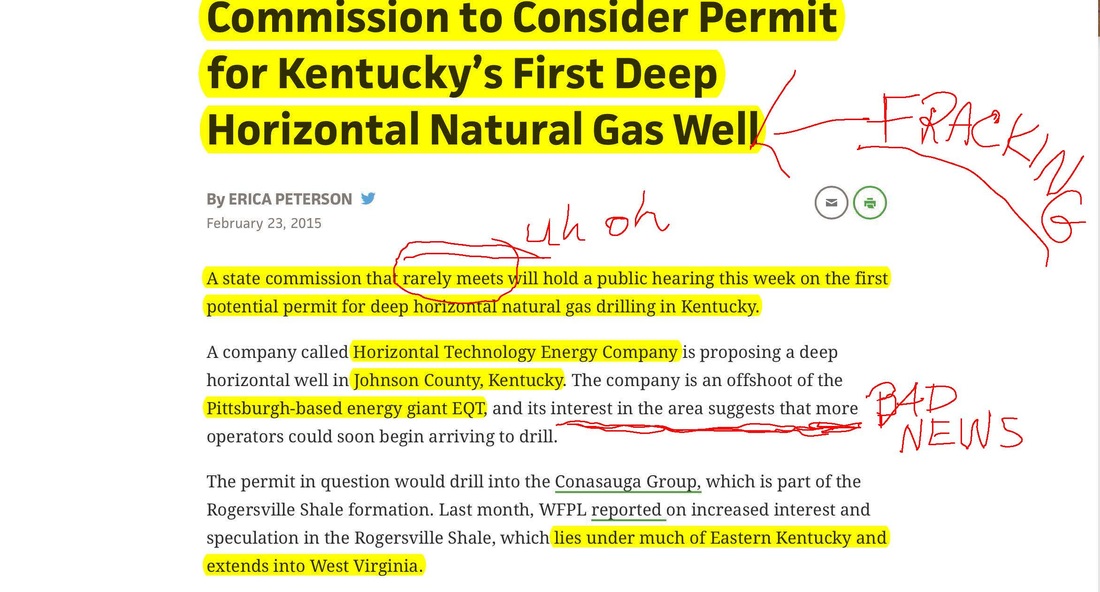
KENTUCKY INFORMATION ON FRACKING
GAS DRILLING IN APPALACHIA
In Kentucky, most gas wells are drilled using pressurized air circulated through the drill pipe (not water) and hydraulic fracture stimulation of natural gas wells is accomplished using nitrogen as the main ingredient. The nitrogen is mixed with a relatively small amounts of water (i.e., several thousands of gallons and not millions) to create a foam that is more efficient in delivering sand to prop open the induced fractures than is straight nitrogen. Most of the water issues associated with natural gas development have to do with hydraulic fracturing (using water) of shale gas wells. Kentucky is pretty much an exception to the general case outlined as follows.
There are two primary water issues in natural gas development: water supply and water quality. In drilling for natural gas (or oil) there is often a surface disturbance similar to a construction site during active drilling and completion. Existing laws cover such things as management of surface runoff and the protection of underground sources of drinking water (USDWs). In most states, USDWs are protected by requiring the installation of pipe in the well (“casing”) that is cemented back to surface specifically for this purpose. Additional strings of casing are installed, each one nested within the previous string, as the well deepens and is required to seal the well from unwanted fluid (brines) entry, maintain integrity of the bore hole, and facilitate isolating the producing zone. Where water-based frac fluids are used, treatment volumes are typically 3 to 5 million gallons per well and can be greater. This can be burdensome on many rural water systems as you generally need treated water; raw water withdrawn from local creeks and ponds contains too much bacteria and other potential pollutants to be effective (too many uncontrolled variables). Fracture stimulation treatment volumes are typically 95.5% water, 4% sand, and the rest additives. Typical additives are used to prevent scale and corrosion of the pipe in the well, reduce friction, increase viscosity (carry sand more effectively), prevent bacterial growth, and acids to help open the induced fractures (brick cleaner/muriatic acid).
Now we get to the meat of the controversy. The first is what are these chemicals? If you google “what’s in frac fluid” you’ll find lists of these chemicals posted by Halliburton, Chesapeake, EQT, and other companies. And, yes, a check of the MSDS shows some are pretty nasty. This brings up the second part of the controversy which is that this is somehow unregulated. The injection of this fluid mixture for the purpose of inducing fractures in an oil or gas reservoir to stimulate production is not regulated under the Underground Injection Control (UIC) provisions of the Safe Drinking Water Act. This is mainly because, especially in a gas well, the fluid is injected, and then as much as possible is removed from the underground reservoir so that gas may be produced. What is regulated under the Clean Water Act and Amendments is the treatment and disposal of the used frac fluid when it is brought back to the surface. The spent frac fluid must either be treated, a potential burden to local waste water treatment facilities, or it must be disposed of in a permitted disposal well (i.e., permitted as an EPA Class I UIC disposal well).
Problems with this fluid can occur if there is a spill, the induced fractures could communicate with pre-existing wellbores, fractures, or faults and reach shallower USDWs, or the stimulation could “go out of zone”, fracture the reservoir seal, and propagate upward to USDWs. It is also possible that the casing in the well could be poorly cemented and the fluids under pressure could migrate upward along the wellbore itself. There are several tools for the simulation and design of fracture stimulation treatments and tools for realtime monitoring of the progress of the stimulation while it is being pumped.
Information provided by the Kentucky Geological Survey.
SOURCE
GAS DRILLING IN APPALACHIA
In Kentucky, most gas wells are drilled using pressurized air circulated through the drill pipe (not water) and hydraulic fracture stimulation of natural gas wells is accomplished using nitrogen as the main ingredient. The nitrogen is mixed with a relatively small amounts of water (i.e., several thousands of gallons and not millions) to create a foam that is more efficient in delivering sand to prop open the induced fractures than is straight nitrogen. Most of the water issues associated with natural gas development have to do with hydraulic fracturing (using water) of shale gas wells. Kentucky is pretty much an exception to the general case outlined as follows.
There are two primary water issues in natural gas development: water supply and water quality. In drilling for natural gas (or oil) there is often a surface disturbance similar to a construction site during active drilling and completion. Existing laws cover such things as management of surface runoff and the protection of underground sources of drinking water (USDWs). In most states, USDWs are protected by requiring the installation of pipe in the well (“casing”) that is cemented back to surface specifically for this purpose. Additional strings of casing are installed, each one nested within the previous string, as the well deepens and is required to seal the well from unwanted fluid (brines) entry, maintain integrity of the bore hole, and facilitate isolating the producing zone. Where water-based frac fluids are used, treatment volumes are typically 3 to 5 million gallons per well and can be greater. This can be burdensome on many rural water systems as you generally need treated water; raw water withdrawn from local creeks and ponds contains too much bacteria and other potential pollutants to be effective (too many uncontrolled variables). Fracture stimulation treatment volumes are typically 95.5% water, 4% sand, and the rest additives. Typical additives are used to prevent scale and corrosion of the pipe in the well, reduce friction, increase viscosity (carry sand more effectively), prevent bacterial growth, and acids to help open the induced fractures (brick cleaner/muriatic acid).
Now we get to the meat of the controversy. The first is what are these chemicals? If you google “what’s in frac fluid” you’ll find lists of these chemicals posted by Halliburton, Chesapeake, EQT, and other companies. And, yes, a check of the MSDS shows some are pretty nasty. This brings up the second part of the controversy which is that this is somehow unregulated. The injection of this fluid mixture for the purpose of inducing fractures in an oil or gas reservoir to stimulate production is not regulated under the Underground Injection Control (UIC) provisions of the Safe Drinking Water Act. This is mainly because, especially in a gas well, the fluid is injected, and then as much as possible is removed from the underground reservoir so that gas may be produced. What is regulated under the Clean Water Act and Amendments is the treatment and disposal of the used frac fluid when it is brought back to the surface. The spent frac fluid must either be treated, a potential burden to local waste water treatment facilities, or it must be disposed of in a permitted disposal well (i.e., permitted as an EPA Class I UIC disposal well).
Problems with this fluid can occur if there is a spill, the induced fractures could communicate with pre-existing wellbores, fractures, or faults and reach shallower USDWs, or the stimulation could “go out of zone”, fracture the reservoir seal, and propagate upward to USDWs. It is also possible that the casing in the well could be poorly cemented and the fluids under pressure could migrate upward along the wellbore itself. There are several tools for the simulation and design of fracture stimulation treatments and tools for realtime monitoring of the progress of the stimulation while it is being pumped.
Information provided by the Kentucky Geological Survey.
SOURCE
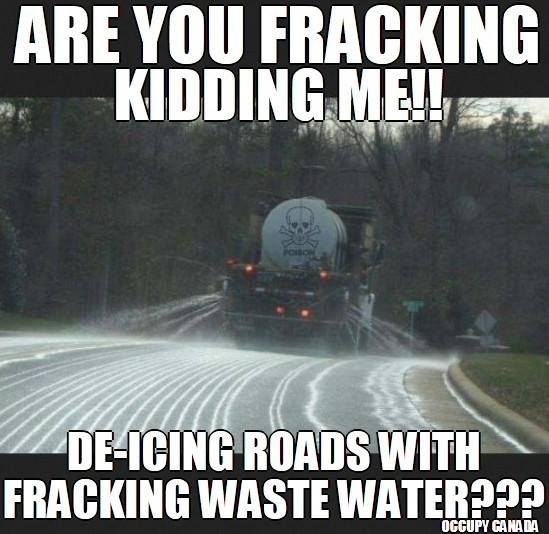
SHARE this very informative list of reading material every person needs to read on Fracking and why we need to ban it in Canada and around the world and stand in solidarity with our First Nations who are on the front lines protecting water for everyone!
Rural Communities Use Fracking Waste to De-Ice Roads http://bit.ly/197a3vc -
Truthdig Environmental group warns of fracking waste on roads >http://bit.ly/1jddxQY
Fracking waste water could be used in house construction (cement) >http://bit.ly/1fg6iSx
WTF?? Scientist sees fracking as the way to dispose of nuclear waste >http://nbcnews.to/19lny8y
BATTLES ARE BEING WON -Nova Scotia is leading the way: bans fracking waste water from New Brunswick http://bit.ly/18zo7L4
Fracking Cancelled near Newfoundland UNESCO World Heritage Site http://bit.ly/197hJxw
U.S Fracking company SWN Is Suspending Its Work in New Brunswick at least until 2015 http://bit.ly/1bo0LJB
Alberta First Nation plans second roadblock to fracking site --http://bit.ly/1eh3tnD
New Brunswick fracking protests are the frontline of a democratic fight >http://bit.ly/174vwlb -
Guardian 'Indigenous communities against fracking like the Elsipogtog First Nation are on the frontlines of defending water and the land FOR EVERYONE' >http://bit.ly/17asTRa -
CommonDreams.org "First Nations people – and the decision of Canadians to stand alongside them – will determine the fate of the planet." http://bit.ly/15MpCoE
Watch This CBC Documentary which just aired June 13: The Nature of Things with David Suzuki 'Shattered Ground' on Hydraulic fracking >http://bit.ly/YMWLKj
Dangerous levels of radioactivity found at fracking waste site > http://bit.ly/1dVZpoZ
"Scientists have for the first time found dangerous levels of radioactivity and salinity at a shale gas waste disposal site that could contaminate drinking water." Fracking wells annually produce 280 billion gallons of toxic waste water destroying environment – report >http://bit.ly/1eK3JrE, http://bit.ly/1bDrl00
"A new report has emerged showing that the practice generated 280 billion gallons of toxic waste last year - containing cancer-causing and radioactive substances." Study links fracking with methane-contaminated drinking water >http://bit.ly/ID8Yi9
Fracking generated 280 billion gallons of wastewater in 2012, enough to submerge Washington D.C in a 22-foot deep toxic lagoon >http://bit.ly/1jjuo20
Hormone-disrupting chemicals found in water at fracking sites >http://lat.ms/19aZJCm
"A study of hydraulic fracturing sites in Colorado finds substances that have been linked to infertility, birth defects and cancer." A New Study Confirms that Fracking Is Indeed Polluting Drinking Water >http://bit.ly/11L8AVw
"Elevated levels of methane and other stray gases have been found in drinking water near natural gas wells, according to new research. In the case of methane, concentrations were six times higher in some drinking water found within one kilometer of drilling operations." >http://nbcnews.to/11Noajw
Full list of Fracking Substances Used in Canada Still Secret >http://bit.ly/11HrEEM
Some of the chemicals in Canada used in fracking includes hydrochloric acid, antifreeze: database (Which can and will leak into the water supply >http://bit.ly/12s4F0Y, http://bit.ly/1bf2gZE -
Archived. Fracking water threat for Lake Ontario feared "The idea of treating fracking fluid at sewage treatment plants and discharging it into the Great Lakes, that's a new issue," >http://bit.ly/o5ryZq
CBC: Fracking causes earthquakes, Two studies confirm >http://bit.ly/HFoSmf, http://bit.ly/QiL0Fm
Fracking Caused 2 Earthquakes In The UK >http://bit.ly/19GYZnP
Fracking Wastewater Disposal Linked to Remotely Triggered Earthquakes -National Geographic http://bit.ly/19814ty
Protecting the right to water means banning fracking >http://bit.ly/ZyxeHx -
rabble.ca Water Contamination from Fracking: Groundbreaking Report >http://bit.ly/12PdFxm
Worth reminding: study established first “definitive” link to well water contamination from shale ‘fracking >http://bit.ly/10IBiAL Six-State Study Confirms Job Numbers Exaggerated by Fracking Industry http://bit.ly/1aK5RP7 -
D&S PLEASE LOOK AT THESE STATISTICS AND FOLLOW UP WITH RESEARCH OF YOUR OWN... RESEARCH THE STATE YOU LIVE IN...I.E., KENTUCKY...THEN DO THE RIGHT THING..."SAY NO TO FRACKING!"
*The above information was provided by Occupy Canada on Facebook.
Rural Communities Use Fracking Waste to De-Ice Roads http://bit.ly/197a3vc -
Truthdig Environmental group warns of fracking waste on roads >http://bit.ly/1jddxQY
Fracking waste water could be used in house construction (cement) >http://bit.ly/1fg6iSx
WTF?? Scientist sees fracking as the way to dispose of nuclear waste >http://nbcnews.to/19lny8y
BATTLES ARE BEING WON -Nova Scotia is leading the way: bans fracking waste water from New Brunswick http://bit.ly/18zo7L4
Fracking Cancelled near Newfoundland UNESCO World Heritage Site http://bit.ly/197hJxw
U.S Fracking company SWN Is Suspending Its Work in New Brunswick at least until 2015 http://bit.ly/1bo0LJB
Alberta First Nation plans second roadblock to fracking site --http://bit.ly/1eh3tnD
New Brunswick fracking protests are the frontline of a democratic fight >http://bit.ly/174vwlb -
Guardian 'Indigenous communities against fracking like the Elsipogtog First Nation are on the frontlines of defending water and the land FOR EVERYONE' >http://bit.ly/17asTRa -
CommonDreams.org "First Nations people – and the decision of Canadians to stand alongside them – will determine the fate of the planet." http://bit.ly/15MpCoE
Watch This CBC Documentary which just aired June 13: The Nature of Things with David Suzuki 'Shattered Ground' on Hydraulic fracking >http://bit.ly/YMWLKj
Dangerous levels of radioactivity found at fracking waste site > http://bit.ly/1dVZpoZ
"Scientists have for the first time found dangerous levels of radioactivity and salinity at a shale gas waste disposal site that could contaminate drinking water." Fracking wells annually produce 280 billion gallons of toxic waste water destroying environment – report >http://bit.ly/1eK3JrE, http://bit.ly/1bDrl00
"A new report has emerged showing that the practice generated 280 billion gallons of toxic waste last year - containing cancer-causing and radioactive substances." Study links fracking with methane-contaminated drinking water >http://bit.ly/ID8Yi9
Fracking generated 280 billion gallons of wastewater in 2012, enough to submerge Washington D.C in a 22-foot deep toxic lagoon >http://bit.ly/1jjuo20
Hormone-disrupting chemicals found in water at fracking sites >http://lat.ms/19aZJCm
"A study of hydraulic fracturing sites in Colorado finds substances that have been linked to infertility, birth defects and cancer." A New Study Confirms that Fracking Is Indeed Polluting Drinking Water >http://bit.ly/11L8AVw
"Elevated levels of methane and other stray gases have been found in drinking water near natural gas wells, according to new research. In the case of methane, concentrations were six times higher in some drinking water found within one kilometer of drilling operations." >http://nbcnews.to/11Noajw
Full list of Fracking Substances Used in Canada Still Secret >http://bit.ly/11HrEEM
Some of the chemicals in Canada used in fracking includes hydrochloric acid, antifreeze: database (Which can and will leak into the water supply >http://bit.ly/12s4F0Y, http://bit.ly/1bf2gZE -
Archived. Fracking water threat for Lake Ontario feared "The idea of treating fracking fluid at sewage treatment plants and discharging it into the Great Lakes, that's a new issue," >http://bit.ly/o5ryZq
CBC: Fracking causes earthquakes, Two studies confirm >http://bit.ly/HFoSmf, http://bit.ly/QiL0Fm
Fracking Caused 2 Earthquakes In The UK >http://bit.ly/19GYZnP
Fracking Wastewater Disposal Linked to Remotely Triggered Earthquakes -National Geographic http://bit.ly/19814ty
Protecting the right to water means banning fracking >http://bit.ly/ZyxeHx -
rabble.ca Water Contamination from Fracking: Groundbreaking Report >http://bit.ly/12PdFxm
Worth reminding: study established first “definitive” link to well water contamination from shale ‘fracking >http://bit.ly/10IBiAL Six-State Study Confirms Job Numbers Exaggerated by Fracking Industry http://bit.ly/1aK5RP7 -
D&S PLEASE LOOK AT THESE STATISTICS AND FOLLOW UP WITH RESEARCH OF YOUR OWN... RESEARCH THE STATE YOU LIVE IN...I.E., KENTUCKY...THEN DO THE RIGHT THING..."SAY NO TO FRACKING!"
*The above information was provided by Occupy Canada on Facebook.


